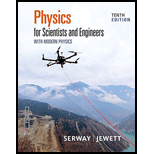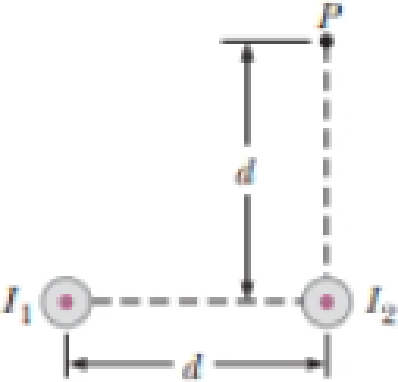
Physics for Scientists and Engineers with Modern Physics
10th Edition
ISBN: 9781337553292
Author: Raymond A. Serway, John W. Jewett
Publisher: Cengage Learning
expand_more
expand_more
format_list_bulleted
Concept explainers
Textbook Question
Chapter 29, Problem 11P
Two long, parallel wires carry currents of I1 = 3.00 A and I2 = 5.00 A in the directions indicated in Figure P29.11 (page 792). (a) Find the magnitude and direction of the magnetic field at a point midway between the wires. (b) Find the magnitude and direction of the magnetic field at point P, located d = 20.0 cm above the wire carrying the 5.00-A current.
Figure P29.11

Expert Solution & Answer
Want to see the full answer?
Check out a sample textbook solution
Students have asked these similar questions
Plz plz no chatgpt pls will upvote .
You want to determine if a new material created for solar panels increases the amount of energy that can be captured . You have acquired 15 panels of different sizes manufactured with different materials including the new material.You decide to set up an experiment to solve this problem .What do you think are the 3 most important variables to address in your experience? How would you incorporate those materials in your experiment?
No chatgpt pls will upvote
Chapter 29 Solutions
Physics for Scientists and Engineers with Modern Physics
Ch. 29.1 - Consider the magnetic field due to the current in...Ch. 29.2 - Prob. 29.2QQCh. 29.3 - Prob. 29.3QQCh. 29.3 - Prob. 29.4QQCh. 29.4 - Consider a solenoid that is very long compared...Ch. 29 - Calculate the magnitude of the magnetic field at a...Ch. 29 - Prob. 2PCh. 29 - In Niels Bohrs 1913 model of the hydrogen atom, an...Ch. 29 - Prob. 4PCh. 29 - Prob. 5P
Ch. 29 - Consider a flat, circular current loop of radius R...Ch. 29 - Prob. 7PCh. 29 - One long wire carries current 30.0 A to the left...Ch. 29 - Determine the magnetic field (in terms of I, a,...Ch. 29 - Prob. 10PCh. 29 - Two long, parallel wires carry currents of I1 =...Ch. 29 - Prob. 12PCh. 29 - Prob. 13PCh. 29 - Prob. 14PCh. 29 - You are part of a team working in a machine parts...Ch. 29 - Why is the following situation impossible? Two...Ch. 29 - Prob. 17PCh. 29 - Prob. 18PCh. 29 - The magnetic coils of a tokamak fusion reactor are...Ch. 29 - A packed bundle of 100 long, straight, insulated...Ch. 29 - Prob. 21PCh. 29 - Prob. 22PCh. 29 - A long solenoid that has 1 000 turns uniformly...Ch. 29 - Prob. 24PCh. 29 - Prob. 25PCh. 29 - Prob. 26PCh. 29 - Prob. 27PCh. 29 - You are working for a company that creates special...Ch. 29 - A solenoid of radius r = 1.25 cm and length =...Ch. 29 - Prob. 30PCh. 29 - Prob. 31APCh. 29 - Why is the following situation impossible? The...Ch. 29 - Prob. 33APCh. 29 - Prob. 34APCh. 29 - Prob. 35APCh. 29 - Prob. 36APCh. 29 - A very large parallel-plate capacitor has uniform...Ch. 29 - Two circular coils of radius R, each with N turns,...Ch. 29 - Prob. 39APCh. 29 - Two circular loops are parallel, coaxial, and...Ch. 29 - Prob. 41APCh. 29 - Review. Rail guns have been suggested for...Ch. 29 - Prob. 43APCh. 29 - An infinitely long, straight wire carrying a...Ch. 29 - Prob. 45CPCh. 29 - Prob. 46CPCh. 29 - A wire carrying a current I is bent into the shape...Ch. 29 - Prob. 48CPCh. 29 - Prob. 49CPCh. 29 - Prob. 50CPCh. 29 - Prob. 51CP
Additional Science Textbook Solutions
Find more solutions based on key concepts
Gregor Mendel never saw a gene, yet he concluded that some inherited factors were responsible for the patterns ...
Campbell Essential Biology (7th Edition)
Practice Problem 1.22 Which of the following alkenes can exist as cis-trans isomers? Write their structures. Bu...
Organic Chemistry
Label each statement about the polynucleotide ATGGCG as true or false. The polynucleotide has six nucleotides. ...
General, Organic, and Biological Chemistry - 4th edition
Why is it unlikely that two neighboring water molecules would be arranged like this?
Campbell Biology (11th Edition)
What are the cervical and lumbar enlargements?
Principles of Anatomy and Physiology
Knowledge Booster
Learn more about
Need a deep-dive on the concept behind this application? Look no further. Learn more about this topic, physics and related others by exploring similar questions and additional content below.Similar questions
- Why can't this be correct: &= 7m?arrow_forwardgive a brief definition of the word "paradigm" as well as an example of a current scientific paradigmarrow_forward7. Are all scientific theories testable in the commonly understood sense? How does this make you feel? How should you proceed as a scientist or engineer with this understanding?arrow_forward
- What is an an example of a hypothesis that sounds scientific but is notarrow_forwardWhat is an example of a scientific hypothesisarrow_forwardMultiverse is called a theory. It has been proposed to account for the apparent and uncanny fine tuning of our own universe. The idea of the multiverse is that there are infinite, distinct universes out there - all with distinct laws of nature and natural constants - and we live in just one of them. Using the accepted definition of the universe being all that there is (matter, space and energy), would you say that multiverse is a scientific theory?arrow_forward
- How is a law usually different than a theoryarrow_forwardA 1.50 mLmL syringe has an inner diameter of 5.00 mmmm, a needle inner diameter of 0.270 mmmm, and a plunger pad diameter (where you place your finger) of 1.2 cmcm. A nurse uses the syringe to inject medicine into a patient whose blood pressure is 140/100. Part A What is the minimum force the nurse needs to apply to the syringe? Express your answer with the appropriate units. View Available Hint(s)for Part A Hint 1for Part A. How to approach the question The force the nurse applies to the syringe can be determined from the fluid pressure and the area of the plunger. The minimum force corresponds to the patient's lowest blood pressure. Use the following equality 760mmofHg=1atm=1.013×10^5Pa760mmofHg=1atm=1.013×10^5Pa.arrow_forwardA 1.50 mLmL syringe has an inner diameter of 5.00 mmmm, a needle inner diameter of 0.270 mmmm, and a plunger pad diameter (where you place your finger) of 1.2 cmcm. A nurse uses the syringe to inject medicine into a patient whose blood pressure is 140/100. Part A What is the minimum force the nurse needs to apply to the syringe? Express your answer with the appropriate units. View Available Hint(s)for Part A Hint 1for Part A. How to approach the question The force the nurse applies to the syringe can be determined from the fluid pressure and the area of the plunger. The minimum force corresponds to the patient's lowest blood pressure. Use the following equality 760mmofHg=1atm=1.013×10^5Pa760mmofHg=1atm=1.013×10^5Pa.arrow_forward
- Is a scientific theory supposed to just be someone's idea about somethingarrow_forwardwhat is the agenda of physicsarrow_forwardWatch the video of Cooper’s play, while conducting and documenting your observation using a chosen observation tool. Case Study 1b - Cooper Carol has asked you to support the babies and toddler’s room educators this week. She has requested that you complete an observation on Cooper, who is a 10-month-old toddler. Carol wants to see how well you conduct an observation and is interested in how you manage to communicate in any observations made, using a strengths-based, non-judgemental, anti-biased approach, as this is a fundamental part of creating a supportive and respectful culture at Little Catalysts ELC. Video: Cooper's play (6:45 min) Resources Module 7 eLearns Template: Learning story observation, Section 1 Template: Running record observation, Section 1 Template: Anecdotal record observation, Section 1 Video: Cooper's play (6:45 min) Complete and upload an observation of Cooper to support educators in future curriculum planning. Choose one (1) of the observation…arrow_forward
arrow_back_ios
SEE MORE QUESTIONS
arrow_forward_ios
Recommended textbooks for you
 Physics for Scientists and Engineers: Foundations...PhysicsISBN:9781133939146Author:Katz, Debora M.Publisher:Cengage Learning
Physics for Scientists and Engineers: Foundations...PhysicsISBN:9781133939146Author:Katz, Debora M.Publisher:Cengage Learning Principles of Physics: A Calculus-Based TextPhysicsISBN:9781133104261Author:Raymond A. Serway, John W. JewettPublisher:Cengage Learning
Principles of Physics: A Calculus-Based TextPhysicsISBN:9781133104261Author:Raymond A. Serway, John W. JewettPublisher:Cengage Learning Physics for Scientists and Engineers with Modern ...PhysicsISBN:9781337553292Author:Raymond A. Serway, John W. JewettPublisher:Cengage Learning
Physics for Scientists and Engineers with Modern ...PhysicsISBN:9781337553292Author:Raymond A. Serway, John W. JewettPublisher:Cengage Learning College PhysicsPhysicsISBN:9781305952300Author:Raymond A. Serway, Chris VuillePublisher:Cengage Learning
College PhysicsPhysicsISBN:9781305952300Author:Raymond A. Serway, Chris VuillePublisher:Cengage Learning College PhysicsPhysicsISBN:9781285737027Author:Raymond A. Serway, Chris VuillePublisher:Cengage Learning
College PhysicsPhysicsISBN:9781285737027Author:Raymond A. Serway, Chris VuillePublisher:Cengage Learning

Physics for Scientists and Engineers: Foundations...
Physics
ISBN:9781133939146
Author:Katz, Debora M.
Publisher:Cengage Learning

Principles of Physics: A Calculus-Based Text
Physics
ISBN:9781133104261
Author:Raymond A. Serway, John W. Jewett
Publisher:Cengage Learning

Physics for Scientists and Engineers with Modern ...
Physics
ISBN:9781337553292
Author:Raymond A. Serway, John W. Jewett
Publisher:Cengage Learning

College Physics
Physics
ISBN:9781305952300
Author:Raymond A. Serway, Chris Vuille
Publisher:Cengage Learning

College Physics
Physics
ISBN:9781285737027
Author:Raymond A. Serway, Chris Vuille
Publisher:Cengage Learning

Magnets and Magnetic Fields; Author: Professor Dave explains;https://www.youtube.com/watch?v=IgtIdttfGVw;License: Standard YouTube License, CC-BY